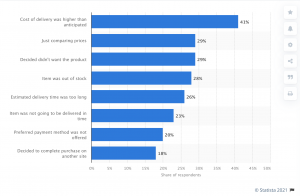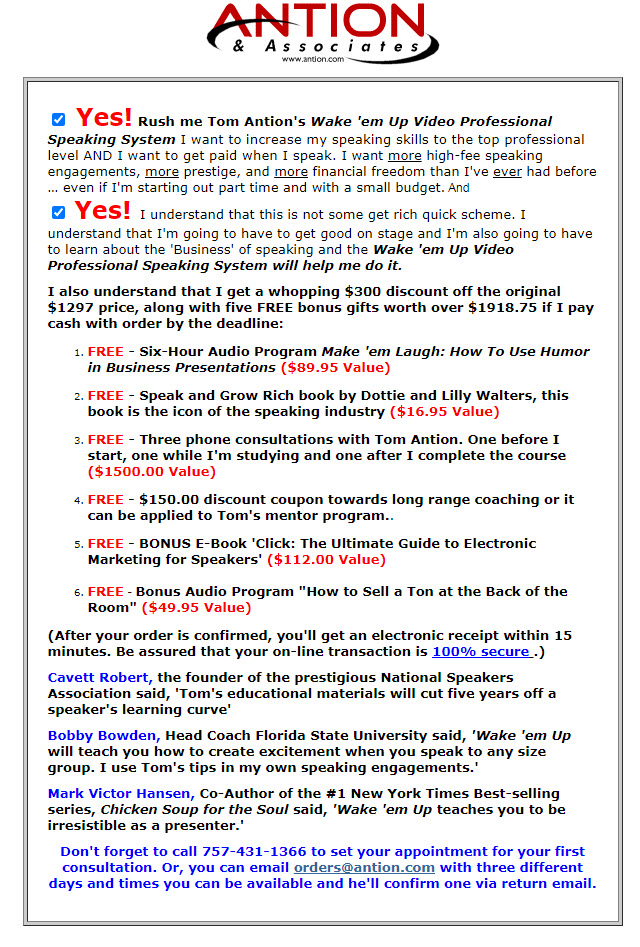“Why did you leave? What did I do wrong? Is this my fault?! Come back!”
What do fishermen and eCommerce business owners have in common?
They both know the sentiment of losing what they have been fighting to get at the very last minute.
Shopping cart abandonment might be one of the most common pet peeves among online retailers. Yet, it is very common. According to recent eCommerce data, online shopping cart abandonment averages around 70 percent. Business owners put a lot of money and effort into moving customers down the sales funnel. When shoppers don’t make a purchase, it might feel like all those efforts were in vain.
[ctt template=”5″ link=”ha7Vf” via=”yes” ]Shopping cart abandonment averages around 70 percent in the eCommerce industry. That doesn’t mean you’re losing 70 percent of your customers, though. Read on to learn more.[/ctt]
What can eCommerce professionals do about it? We asked academics, eCommerce, and business experts just that. Here are some insights that can help prevent, manage, and reduce shopping cart abandonment.
1. Patience is a Virtue: Calculate Shopping Cart Abandonment Rate Correctly
Here is a thing to consider. People love to window shop. We browse, we dream about a purchase, we even add the item to our cart. But then…We remember we have something on the stove or our dog needs a walk. Or maybe we just need a little time to brew over a reason to buy something. The point is, we might still make the purchase. Just not right now.

Marketing professor and retail expert Jie Zhang says that shopping cart abandonment retailers can relax a bit. Online retailers allow shoppers to save items in virtual carts. As a result, consumers often break up a shopping task into multiple shopping sessions. This has direct implications on shopping cart abandonment rates and further marketing campaigning.
Zhang says the right way to calculate shopping cart abandonment is to trace the same virtual cart over multiple shopping sessions. Additionally, shoppers have the habit of adding multiple similar items to their carts while making purchase decisions. Say, for example, loading up an online cart with five different pairs of boots while you browse, but only intending to buy one.
The researchers find it pays off to wait when sending reminder email promotions to consumers. Rushing out reminder emails too quickly might entice customers to pick up old shopping carts, but their purchase intentions would not be as high yet. This could leave money on the table by missing would-be additional purchases or wasting promotional spending.
“Consumers will be more likely to submit a cart and fill it with more items, spending more money, if retailers wait a few days to send promotional emails.” Jie Zhang, marketing professor, University of Maryland’s Robert H. Smith School of Business
2. Find the Escape Route: Analyze Shoppers’ Behaviors
Sadly, some shoppers might never return to their abandoned carts. And they may have good reasons for that. (Yes, after all, it might very well be your fault!) In that case, analyzing customers’ behavior might shine some light on how you can improve your conversion rates.
“Studying Google Analytics can really help shed light on what could be done better to ensure a higher checkout rate,” says Antti Alatalo, CEO and founder of SmartWatches 4U. “Look at the bounce rate and the session time. If you see that people are dropping off once on a certain page then that could point out the need to improve content or design. Consider all possibilities by evaluating factors such as the amount of traffic per page, the exit pages, the devices used, etc.”
When one customer leaves without purchasing, it might not be a big deal. When you have a massive exodus on your hands, you might need to make some improvements to the shopping process. So, find out the reason behind the abandonment and address it.
You can use tools like Qualaroo and Picreel to create exit popups and collect feedback from your customers and analyze why they are leaving without purchasing

3. Simplicity For The Win: Make The Checkout Process Faster And Easier
If, after some research, it becomes clear that something about the online experience is turning customers off, it’s time to get to work. A famous Leonardo DeVinci quote proclaims that “simplicity is the ultimate sophistication.” Customers are busy. They have things to do, dogs to walk, stoves to attend to. They do not want to put any extra effort into their buying experiences. Simplifying all processes can make a big difference.
“If someone has to step away from their computer to grab a credit card or other payment method, that’s another opportunity for a lost sale,” says Phil Strazzulla, the CEO of Select Software. “One of the best ways to reduce shopping cart abandonment is to take out that process entirely. Using digital payment methods like Google Wallet, Apple Pay and PayPal make one-click purchases easy and thoughtless.”

Strazzulla also recommends reducing checkout time. Using the information stored in a customer’s browser can make checkout fast and efficient. “If someone just has to click a few buttons to check out, they won’t have time to second-guess a purchase,” he says.
4. Appeal to Human Nature: Incentivize Order Completion
Here is a bit of neuroscience wisdom: people buy with their emotions, then justify their purchases with logic. In fact, Harvard Business School professor Gerald Zaltman says that 95 percent of our purchase decision-making takes place in the subconscious mind. So when customers put items in shopping carts, they are emotionally ready to buy them. What they need is that logical push. So give it to them with some good old incentives.
People buy with emotion and justify their purchases with logic.
You have to win someone’s heart before you win their head.
Whether we know it or not, we largely base decisions on our gut instincts and then test them with rationale.
— Corey Haines ???? (@coreyhainesco) May 16, 2021
“Offer incentives for completing the sale such as a free upgrade, product, strategy call, or something of value that is time-sensitive,” says Terry Thompson, author and entrepreneur. “Once the sale is made, ensure to include a value-added email sequence immediately following the sale. This sequence should focus solely on the customer to add value and not on any upsells or additional calls to action to garner a sale.”
5. Follow The Leads: Send a Series of Shopping Cart Abandonment Emails
Just because a customer abandoned his or her cart doesn’t mean the company lost the business. The customer is still a lead. Follow it.
Brad Touesnard, Founder and CEO of SpinupWP, recommends crafting multiple email campaigns in a way to bring them back to their abandoned carts.
“We have won back up to 11 percent of lost sales using this tactic,” Touesnard says. “Send three emails, the first after one hour, the second after one day, and the third after three days. Start your email with a short, attention-grabbing subject line. For example, Dollar Shave Club uses the line, ‘Where did you go?’”
Touesnard advises structuring emails with easy-to-read bullet-point copy, listing the benefits visitors will enjoy when they purchase a product. Including a visual of the product can add impact, he says. Offering a 100 percent money-back guarantee can reassure any doubters. Providing a link for visitors to easily return to their carts and continue with their purchases makes the process effortless and easy.
6. Get Personal: Send Personalized Texts
Another way to appeal to customers’ emotions is to personalize communications with them. Doing it over text is an innovative tactic that can feel even more personal. Emotive SMS text messaging offers the means to do just that. The company offers human-to-human conversational texts to help eCommerce companies.
The logic behind this is meeting consumers where they spend most of their time online (hint, hint: their phones), but steering away from mass-produced blasts and lengthy promotional messages. Emotive’s SMS messages are short and to the point, averaging only 160 characters including spaces. The communications are created via a combination of AI automation and human assistance to create a two-way conversation between the brand and the consumer.
According to Brian Zatulove, the CEO and Co-Founder of Emotive, the text message platform converts an average of 8 to 10 percent of abandoned shopping carts. That’s a significant increase compared to a standard one-way text message blast that converts roughly 1 – 2 percent.
7. Use Psychology: Personalize and Tailor Reminders to Products.
Another sure way to appeal to customers’ emotions and return them to their abandoned carts is to personalize communications even further. The cocktail party effect is a psychological principle that explores the human need for personal relevance in their interactions. (The name comes from the idea that people will tune into a conversation as soon as they hear their own name or something that is directly relevant to them, even if they are in a noisy cocktail party room.)
“Tailor reminder emails to the products that are waiting in the customer’s cart,” says Ouriel Lemmel, CEO of WinIt. “If customers have wine in their carts, mention how they might want to purchase it before the weekend to enjoy with their friends. If the customer has a book, send her a synopsis and recent reviews to remind her why it might be a great purchase.”
Relevance is everything and personalization is a winning strategy.
8. Get algorithms on Your Side: Use Remarketing Tactics to Target Shopping Cart Abandonment
Emails and text are not the only ways you can get in touch with your escaped customers. Social media marketing is big in modern times. Why not use it?
“Remarketing is essential for eCommerce retailers as only a very low proportion of your visitors are going to convert in a single session,” says Dave Nilsson Founder and Director of The Converted Click. “Use Facebook ads to give your visitors a visual reminder of what they are missing by not completing their purchase. For products whose appeal would be better conveyed by text, Google AdWords and Bings Ads provide a great alternative.”
Everyone and her mother are on social media. Meet your customers there with some personalized targeted materials.
9. Cheer Your Customer On: Shopping Cart Sell Thru
Whatever strategy a business employs to fight shopping cart abandonment, the more creative it is, the better.
Tom Antion, founder of the Internet Marketing Training Center of Virginia offers an interesting way to prevent abandoned carts.
“When a person puts one of my large ticket items in their cart I put a mini slightly interactive sales letter for the exact same product they’re buying at the top of the cart,” he says. “It has two checkboxes that don’t really do anything, but they are blank and the customer usually checks them as they read.”

Another strategy Antion offers shortens the time a customer lingers on the website following a large-ticket item to the cart.
“I use a one-step checkout that does not have a ‘continue shopping’ button,” he says. “I don’t want people searching around my cheaper products when they have a $1000.00 purchase in the cart.”
Tricky? Maybe a little bit. Effective? You bet!
Shopping Cart Abandonment: Use Creativity to Fight It
Selling in the eCommerce space is not an easy task. Attracting customers to your site is only part of the game. Having them complete their purchases is yet another. So if you encounter shopping cart abandonment, make your presence known. Use personalized messaging ad cleverly offer discounts. Use interesting tactics that prevent the cart from being abandoned in the first place. Whatever you do, get creative. After all, both eCommerce professionals and fishermen know this simple truth: “a fish in the pan is worth two in the pond.”





